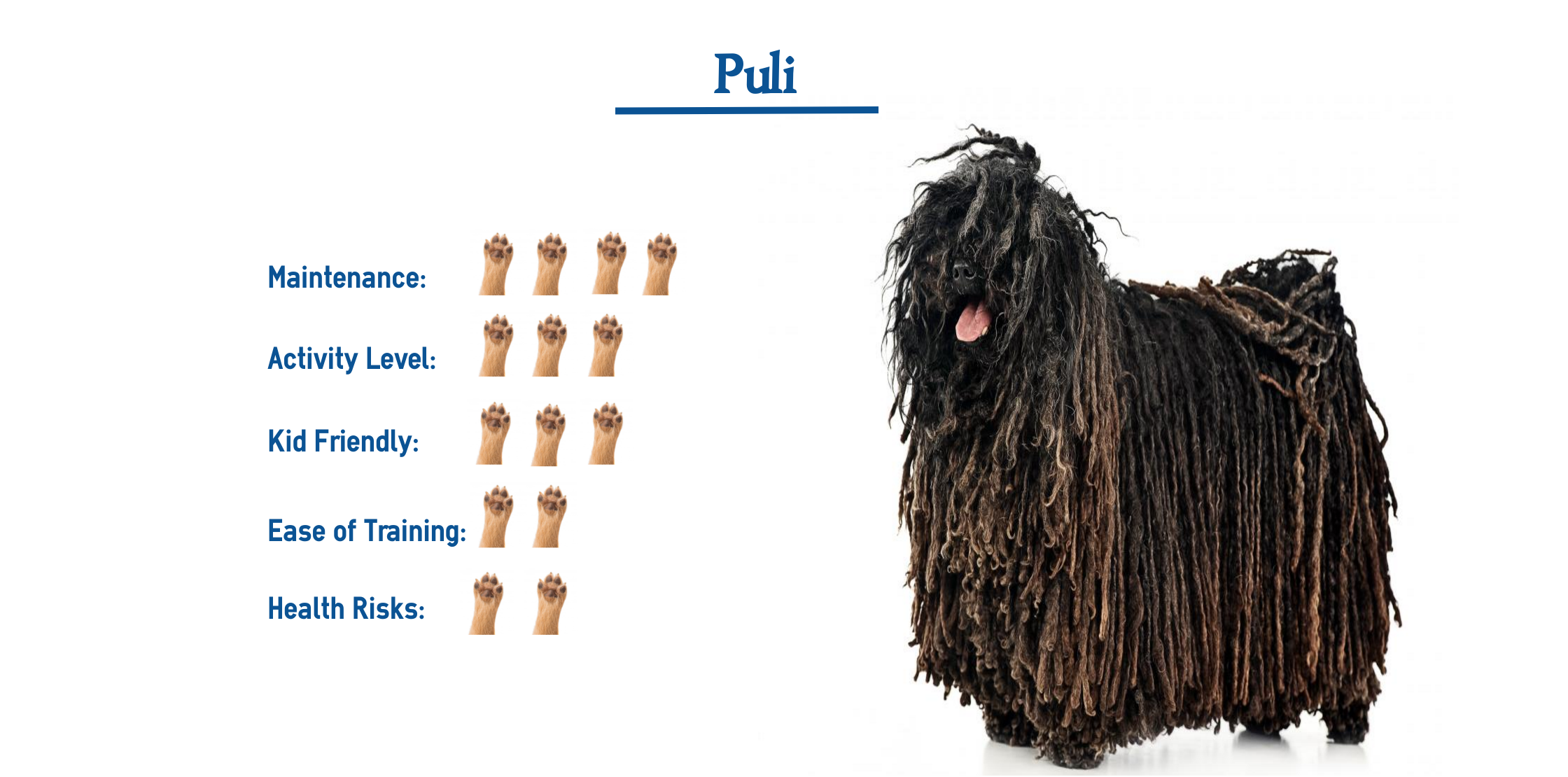Now if you’re considering purchasing a Puli puppy or, better yet, adopting a Puli rescue dog, there’s one thing you need to know right away: you’re going to get a lot of folks asking you about your new unique-looking dog!
Which is why…
We wanted to take a moment and discuss this breed so that if you ever get a chance to own one, not only will you know whether or not you’ll likely “mesh” well with one of these guys, but you’ll also be able to answer some if not most of the questions you’ll probably be asked!
So, without further ado, let’s dive right in.
Puli Dog Breed Fact Facts
Country of Origin: Hungary
Original Purpose: Sheep herding
Height: 16 to 17 inches
Weight: 25 to 35 pounds
Dog Breed Classification: Herding group
Life Span: 12 to 16 Years
Origin of the Puli Dog Breed
The Puli is one of the oldest Hungarian dog breeds. He has been an integral part of Hungarian life for more than a thousand years. He was most likely brought to Hungary by the invading Magyar tribes from Central Asia. And because these dogs are very similar to the Tibetan Terrier, they may be initially from the Himalayas.
Now it should be…
They noted that the Puli dog breed is the smallest of the Hungarian Sheepdogs. The farmers used them as herding dogs, mainly to protect the sheep and the cattle. Pulis were of different types – Black-Coated Pulis, White-Coated Pulis, etc. Both Black and White Puli have their uses.
For a long, long time…
The Puli dog breed was pretty much a “forgotten” breed. Now we’re not 100% certain “why” this breed hasn’t always received the attention that it should have over the years, but fortunately for all of us, way back in 1912, this breed did experience a “revival,” so to speak which is essentially what they still exist today.
Then a new breed standard was approved in 1924 by the Federation Cynologique Internationale, which led to a surge in their popularity and ultimately led to their import into the United States shortly after that. It was then that this “new” Puli breed was recognized by the American Kennel Club in 1936. The Puli Club of America was formed in 1951.
Physical Characteristics
Pulis are a mid-sized breed of dog. Males are 17 inches tall, and females are about 16 inches tall. Male dogs weigh 30 to 35 pounds, and females 25 to 30 pounds. They are easily recognizable because of their dreadlocks or corded coat. It takes a Puli about four years to grow the fully corded coat.
The coat
It hides the fact that the Puli has a solid, muscular body. He has excellent stamina and can do incredible physical work as a herding dog or working dog.
His coat comes in different colors: white, gray, black, reddish black, and light brown.
Grooming
…Is not easy with the Puli, for apparent reasons. His coat must be brushed almost every day, and he must be given a bath every few weeks. Otherwise, his dreadlocks can get all tangled up.
Temperament and Personality
The Puli is one of the most intelligent dogs out there. He may be stubborn and independent-minded sometimes, but he is always loyal to his owners. He is smart and does very well in all dog sports – obedience, agility, flyball, etc. We should note that Puli responds well to kind, consistent, and firm treatment. His training should begin as early as possible when he is still a puppy. Early socialization is also crucial so that he gets over his suspicious nature.
But remember…
This dog gets bored quickly, and when he gets bored, he can resort to destructive activities. That is why you should make sure he gets enough playtime and exercise. Daily walks are a must. And that at his “core,” the Puli is an outdoor dog, better suited to the countryside or large estates, but he hates being left outside the house alone, in the lawn or backyard. He has to stay inside the house with his human family, who he loves so much. He deserves that!
Potential Health Problems
Pulis are among the healthiest dog breeds, with a life expectancy of 12 to 16 years. But like all purebred breeds, they are prone to specific health issues. Please know these problems if you want to take this dog home. The Puli may suffer from…
- Hip Dysplasia,
- Progressive Retinal Atrophy (PRA),
- Cataracts.
And while many of these conditions may not be life-threatening, they can become quite expensive, particularly if they become recurring issues. This is why we here at IndulgeYourPet also recommend that any new pet owner take a moment and see what it might cost for you to purchase a pet insurance policy for your new animal.
Now will a pet insurance policy be suitable for everyone?
No, probably not. But until you fully understand what these policies “will” and “won’t” cover and how much these pet insurance policies cost, how will you know if one might be right for you?
For more information on who we feel currently offers the “best” pet insurance policies out there, we would encourage you to check out our Best Pet Insurance Policies article.



